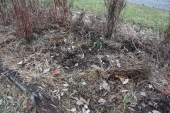posted 1 year ago
Wow folks! Thanks for all the replies! Much appreciated.
Sorry for the late response - I've been recovering from some surgery.
I'm going to try one post here to respond to all of your helpful comments and questions.
I apologize in advance for its length.
I should probably go into more detail regarding how I constructed my beds.
We had just moved to the area in a newly constructed house, with no local gardening support system. 1 or 2 local nurseries not offering their own composting and big box stores were my materiel sources. There appears to be a real dearth of locally source-able organic mulch and compost.
They are raised beds, using the Vego system for containment, 30 inch height. I used a fairly "classic" layered material approach.
Bottom of beds lined with brown cardboard, avoiding colored/dyed sources. Filled to approx 50% with local, bulk wood chips, mostly pine/fir (I live in Washington state).
Next layer is bagged, "big-box" mulch, about 4-6 inch depth, used for budgetary reasons.
The remainder of the depth was a combination of about 50% bulk local topsoil, 40-45% bagged compost and bagged cow manure.
I used a combination of direct sowing and transplants. Pretty much everything I sowed would germinate and then after about a week or so, growth would stall. Some seedlings like cilantro and oregano would show yellowing. Others, like beets and carrots would just not grow much beyond 1 or 2 inches in height. Tomato transplants limped along with low yields. Pole beans grew, but were sub-par in height obtained and in production. Onion and garlic sets barely grew. Lots of leaf yellowing and slow growth of squashes, in spite of very good luck with pests and powdery mildew. I doubt I got more than 2 or 3 zucchini and yellow squashes the whole season. Transplants of sage, rosemary and garlic chives barely grew. Some co-planting of marigolds also grew very slowly and poorly.
Obviously, the beds settled several inches since construction. I will need to bring them back up to full depth with amendments soon. Probably will use a combination of 50% topsoil, 30% good quality organic bagged compost and the balance as potting soil. Seriously considering biting the bullet and using G&B organics products for these sources.
There certainly seems to be a wealth of possible fungal inoculations I could choose from. The question in my mind is how to add them. I want to do minimal tilling, so it seems there are two possible ways to go: (1) Combine the mycorrhizal source with my top dressing for this season or (2) bore holes down to the wood chip layer from the top and get the fungi down to the interface. That would obviously be more work.
Going forward during the season, I'm also planning to use a kelp supplement regularly, both as a tea and direct foliar spraying.
Thanks again, everyone!

 7
7




 9
9




 2
2




 9
9




 5
5





 5
5




 4
4














 3
3




 4
4




 7
7


















